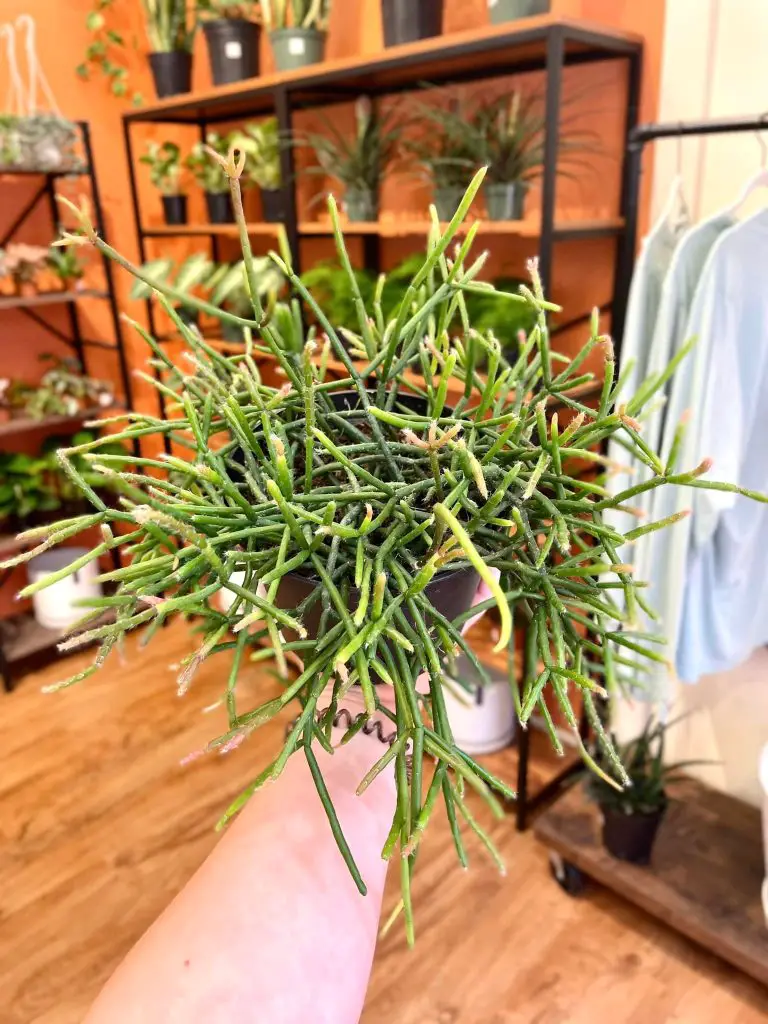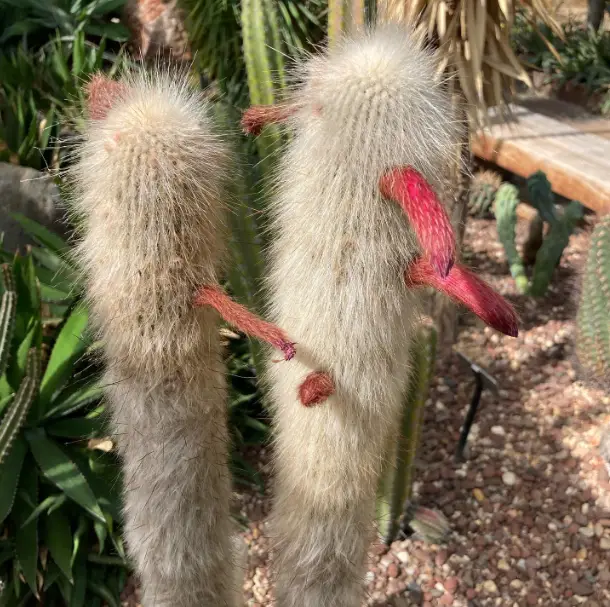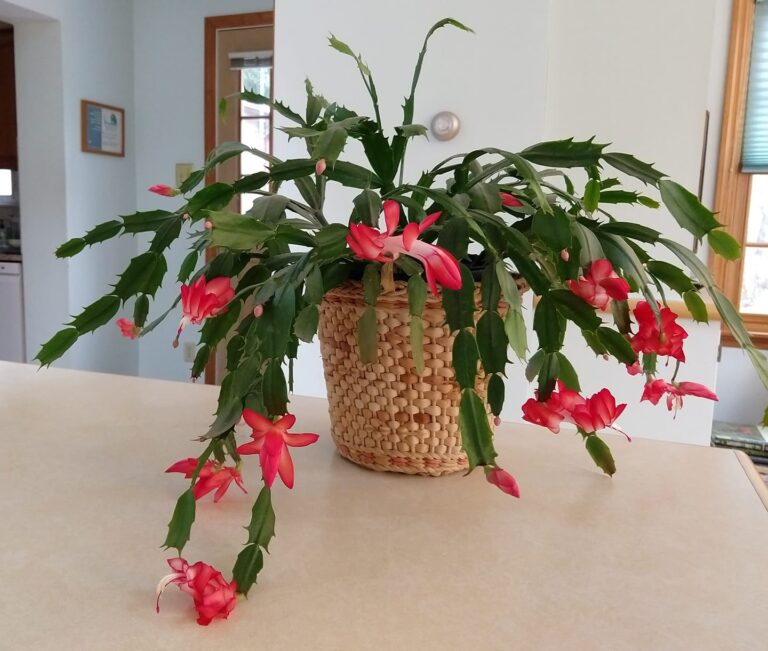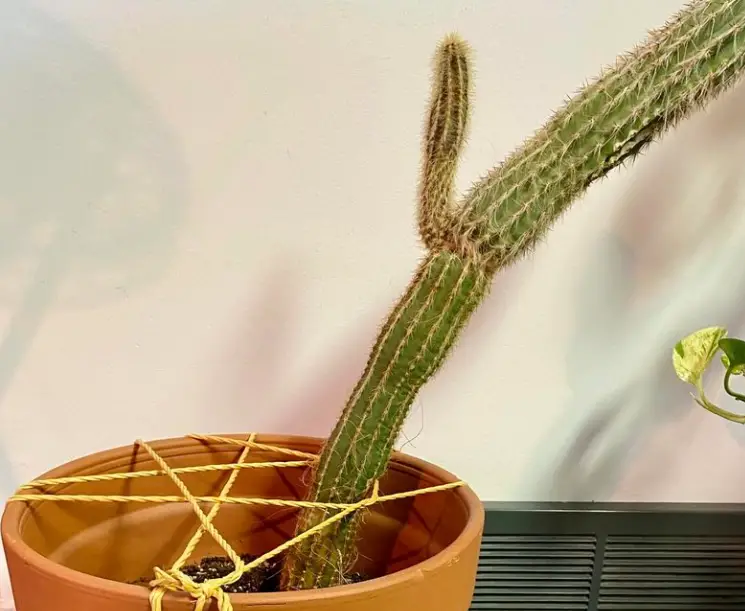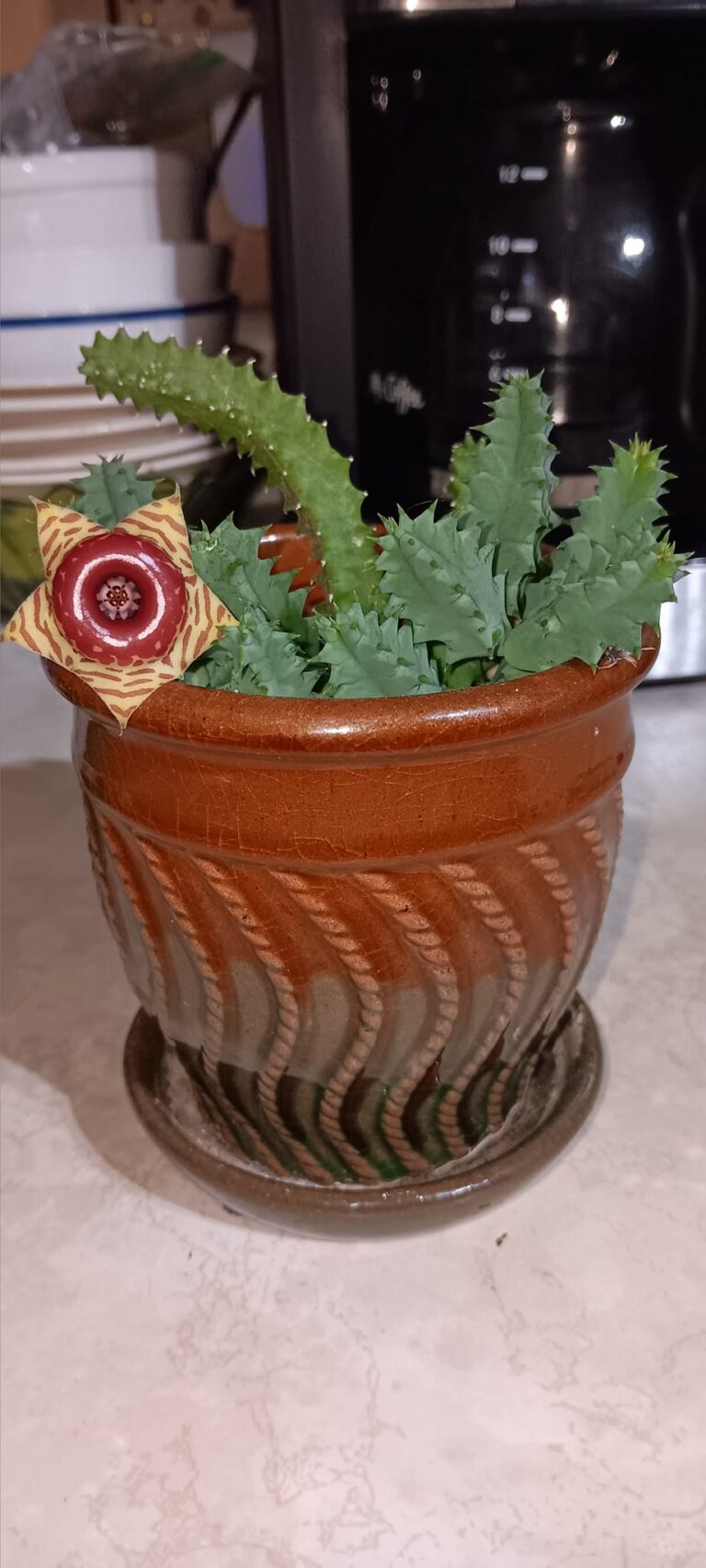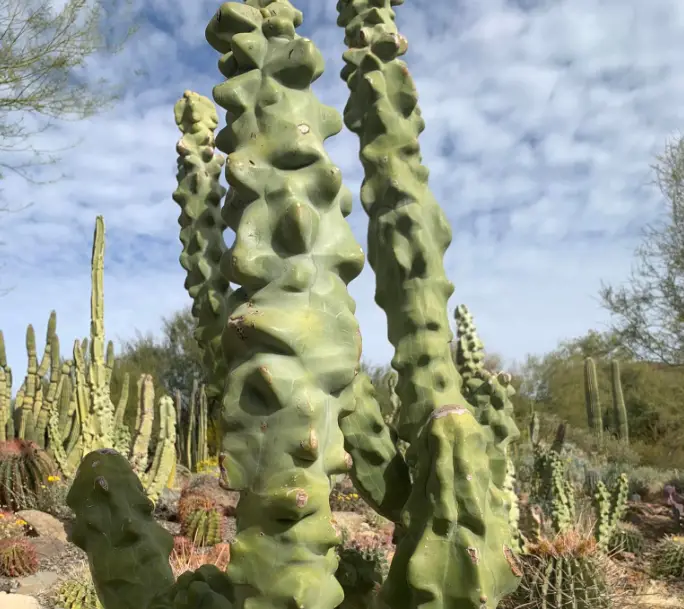6 Reasons: Why Is My Mistletoe Cactus Turning Brown?
If you’re like me, you’ve fallen in love with the quirky, cascading tendrils of your mistletoe cactus (Rhipsalis baccifera). Its lush, green, spaghetti-like stems add a touch of whimsy to any home, whether draped over a bookshelf or spilling from a hanging pot.
But when those vibrant strands start turning brown, it’s enough to make any plant parent panic. I’ve been there, staring at my browning cactus, wondering what I did wrong. Don’t worry—I’ve done the research, consulted experts, and revived my own mistletoe cactus.
In this guide, I’ll walk you through why your mistletoe cactus is turning brown, how to fix it, and how to keep it thriving. Let’s dive in!
Mistletoe Cactus Overview
Before we tackle the browning issue, let’s get to know this unique plant. The mistletoe cactus, also called Rhipsalis baccifera, is a tropical epiphytic cactus native to Central and South America.
Unlike its desert-dwelling cousins, this cactus loves humidity, indirect light, and a bit of TLC. It’s a low-maintenance houseplant, making it perfect for any home. Its long, slender stems can grow up to 6 feet, creating a stunning, trailing effect.
But when those lush stems turn brown, it’s a sign your plant is stressed. Let’s explore the reasons why this happens and how to bring your cactus back to life.
Why Is My Mistletoe Cactus Turning Brown?
I’ve learned the hard way that browning in a mistletoe cactus usually points to one (or more) of these culprits: watering issues, light problems, humidity levels, temperature stress, pests, or disease. Here’s a detailed breakdown of each cause, along with fixes tailored for American homes.
1. Overwatering or Underwatering
Watering is where most of us go wrong—I know I did! Mistletoe cacti need a careful balance. Too much water, and the roots rot, causing the stems to turn brown and mushy. Too little, and the stems dry out, becoming brittle and brown.
- Signs of overwatering: Soft, mushy, or discolored stems, especially near the base. The soil feels soggy.
- Signs of underwatering: Wrinkled, shriveled, or crispy brown stems. The soil is bone-dry.
How to Fix
- Check the soil before watering. Stick your finger an inch into the potting mix—if it’s dry, water thoroughly until it drains out the bottom.
- Use a well-draining potting mix, like a blend of cactus soil and perlite. I mix my own using 50% potting soil, 30% perlite, and 20% orchid bark for extra aeration.
- Water every 1–2 weeks in spring and summer, and reduce to every 3–4 weeks in fall and winter. In drier regions like Arizona, you might water more frequently, while in humid areas like Louisiana, you can water less.
- Ensure your pot has drainage holes. I learned this the hard way after drowning my first cactus in a decorative pot with no holes!
Pro Tip: According to the University of Florida IFAS Extension, overwatering is the leading cause of houseplant death. Always err on the side of underwatering for cacti.
2. Incorrect Lighting
Mistletoe cacti thrive in bright, indirect light. Too much direct sunlight scorches the stems, turning them brown, while too little light causes them to weaken and discolor.
- Signs of too much light: Brown, crispy spots on the stems, especially on the side facing the window.
- Signs of too little light: Pale, yellowish, or browning stems that look thin and weak.
How to Fix
- Place your cactus near an east- or north-facing window for gentle, indirect light. In my Chicago apartment, I keep mine a few feet from a south-facing window with a sheer curtain to filter the sun.
- If you’re in a sunny state like California, avoid placing it in direct afternoon sun. Use a light meter to ensure 1,000–2,000 foot-candles of light.
- If your home lacks natural light (hello, Seattle winters!), supplement with a grow light. The Missouri Botanical Garden recommends full-spectrum LED grow lights for indoor plants.
3. Low Humidity
Unlike desert cacti, mistletoe cacti crave humidity because they’re epiphytes, naturally growing on trees in humid rainforests. Many American homes, especially those with central heating or air conditioning, have dry air that can stress your cactus, leading to browning.
Signs of low humidity include dry, shriveled, or browning stems, especially at the tips.
How to Fix
- Aim for 40–60% humidity. I use a hygrometer to monitor levels in my home.
- Mist your cactus 2–3 times a week with distilled water to avoid mineral buildup. I mist mine in the morning so the stems dry by evening, preventing fungal issues.
- Group your cactus with other plants to create a humid microclimate, or place a pebble tray filled with water beneath the pot.
- In dry climates like Nevada, consider a small humidifier. The Oregon State University Extension suggests humidifiers for tropical houseplants in arid regions.
4. Temperature Stress
Mistletoe cacti prefer temperatures between 60–80°F (15–27°C). Cold drafts or sudden temperature swings can cause browning. Common signs of temperature stress include browning or blackening stems, especially near windows or vents.
How to Fix
- Keep your cactus away from drafty windows, air conditioning vents, or heating radiators. In my home, I move my cactus away from windows in winter to avoid cold drafts.
- Maintain a consistent temperature. If you’re in a colder region like Michigan, use a space heater to keep the room warm, but don’t place the plant too close.
- The Royal Horticultural Society notes that tropical cacti like stable, warm conditions year-round.
5. Pests
Pests like spider mites, mealybugs, or scale can suck the life out of your mistletoe cactus, causing browning as the plant weakens. Tiny webs (spider mites), white cottony patches (mealybugs), or small brown bumps (scale) on the stems are common signs of pests. Browning often follows as the plant loses vitality.
How to Fix
- Inspect your cactus regularly. I use a magnifying glass to spot tiny pests early.
- Wipe affected areas with a cotton swab dipped in 70% isopropyl alcohol to remove pests.
- Spray with neem oil or insecticidal soap every 7–10 days until the pests are gone. I mix 1 teaspoon of neem oil with 1 quart of water for a safe spray.
- Isolate the plant to prevent pests from spreading to your other houseplants.
6. Fungal or Bacterial Infections
Overwatering or high humidity without proper airflow can lead to fungal or bacterial infections, causing brown, mushy spots on the stems. Common signs of infection are soft, brown, or black patches that spread, often with a foul odor.
How to Fix
- Cut away affected stems with sterilized scissors. I disinfect mine with alcohol between cuts to avoid spreading the infection.
- Improve airflow by spacing out your plants or using a small fan.
- Reduce watering and misting until the plant recovers.
- Apply a fungicide labeled for houseplants if the problem persists. Check with your local nursery for recommendations.
How to Revive a Browning Mistletoe Cactus
If your cactus is already browning, don’t give up hope! Here’s how I revived mine:
- Check how much of the plant is affected. If only a few stems are brown, you can save it. If the entire plant is mushy, it may be too late.
- Use clean, sharp scissors to cut away brown or mushy stems. Cut back to healthy, green tissue.
- If the soil is soggy or smells bad, repot in a fresh, well-draining mix. I use a terracotta pot for better airflow.
- Adjust your care and correct the issue (water, light, humidity, etc.) based on the cause. Place the plant in a bright, humid spot with good airflow.
- Be Patient, as new growth may take weeks. I saw my cactus perk up after about a month of consistent care.
Preventing Browning in the Future
When I first got my mistletoe cactus, I treated it like a desert cactus—big mistake! I left it in direct sun and barely watered it, thinking it was tough. The stems turned brown and crispy, and I was devastated.
After researching and experimenting, I moved it to a shady spot, started misting, and used a better potting mix. Within weeks, new green growth appeared, and now it’s the star of my living room. Once your mistletoe cactus is back to health, keep it that way with these tips:
- Water only when the soil is dry, and mist regularly in dry climates.
- Rotate the plant every few weeks for even light exposure.
- Inspect monthly to catch issues such as pests early.
- Reduce watering in winter and increase humidity during the heating season.
- Use a diluted, balanced fertilizer (like 10-10-10) once a month during spring and summer. I use a liquid fertilizer at half strength to avoid overfeeding.
FAQs
Here are quick answers to the frequently asked questions about mistletoe cactus browning:
Q: Can I save a completely brown mistletoe cactus?
A: If the entire plant is brown and mushy, it’s likely beyond saving. But if some stems are still green, trim away the brown parts and follow the revival steps above.
Q: How often should I water my mistletoe cactus?
A: Water every 1–2 weeks in the growing season (spring/summer) and every 3–4 weeks in fall/winter. Always check the soil first.
Q: Is direct sunlight okay for my mistletoe cactus?
A: No, direct sunlight can scorch the stems. Stick to bright, indirect light.
Q: Why are the tips of my cactus turning brown?
A: Tip browning is often due to low humidity or underwatering. Mist regularly and ensure the soil stays lightly moist.
Q: Can I propagate my mistletoe cactus if some stems are healthy?
A: Yes! Cut a healthy 4–6-inch stem, let it callus for a day, and plant in moist, well-draining soil. Keep it humid and warm until roots form.
Conclusion
A browning mistletoe cactus can be a wake-up call, but it’s not the end of the world. By identifying the cause—whether it’s watering mishaps, light issues, or pests—you can nurse your plant back to health and keep it thriving in your home.
I’ve shared my own mistakes and successes to help you avoid the same pitfalls. With a little care, your mistletoe cactus will be cascading with lush, green stems in no time. Have questions or tips of your own? Drop them in the comments below—I’d love to hear from fellow plant lovers!
Additional Resources
For more expert advice, check out these sources:
- University of Florida IFAS Extension: Houseplant Care
- Missouri Botanical Garden: Indoor Plant Lighting
- University of California IPM: Houseplant Pests
- Royal Horticultural Society: Cactus Care
- North Carolina State Extension: Plant Propagation
Tim M Dave is a gardening expert with a passion for houseplants, particularly cacti and succulents. With a degree in plant biology from the University of California, Berkeley, he has vast experience in gardening. Over the years, he has cultivated a vast collection of desert plants and learned a great deal about how to grow and care for these unique companions.
